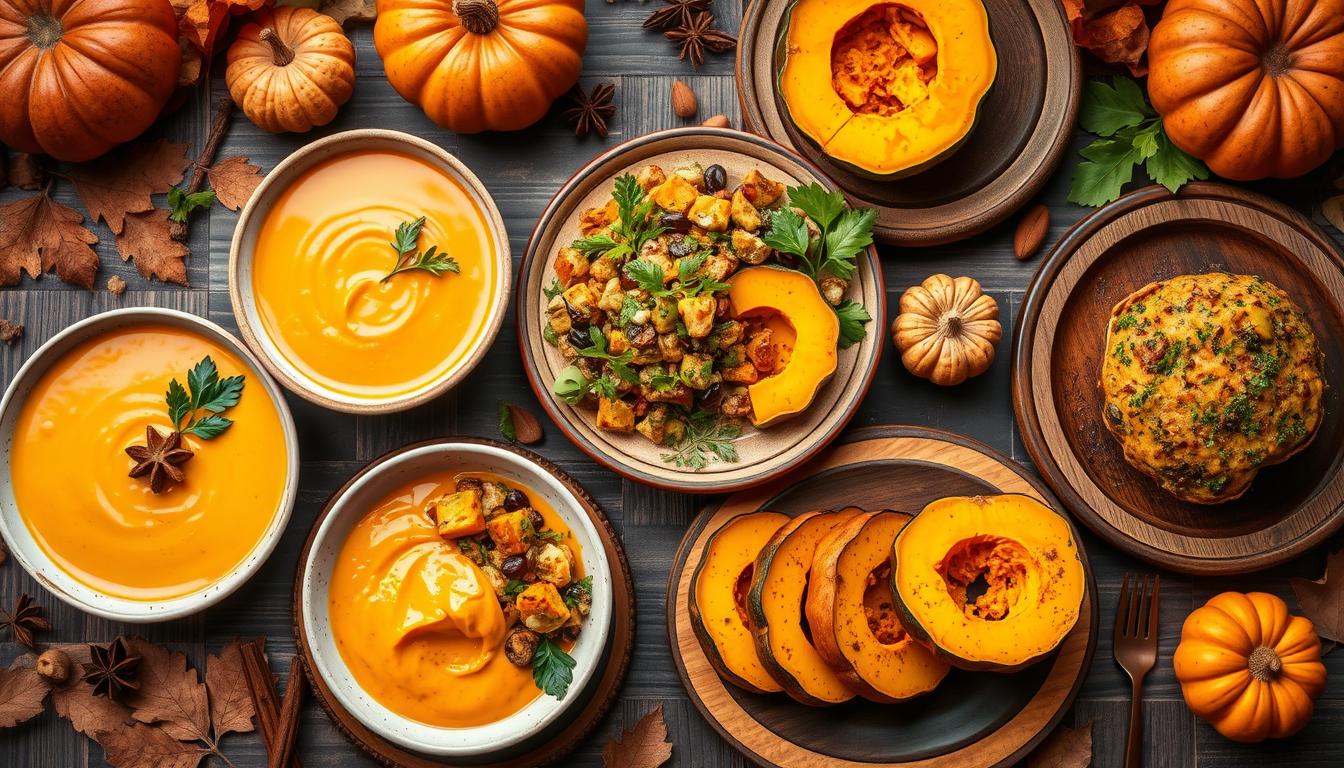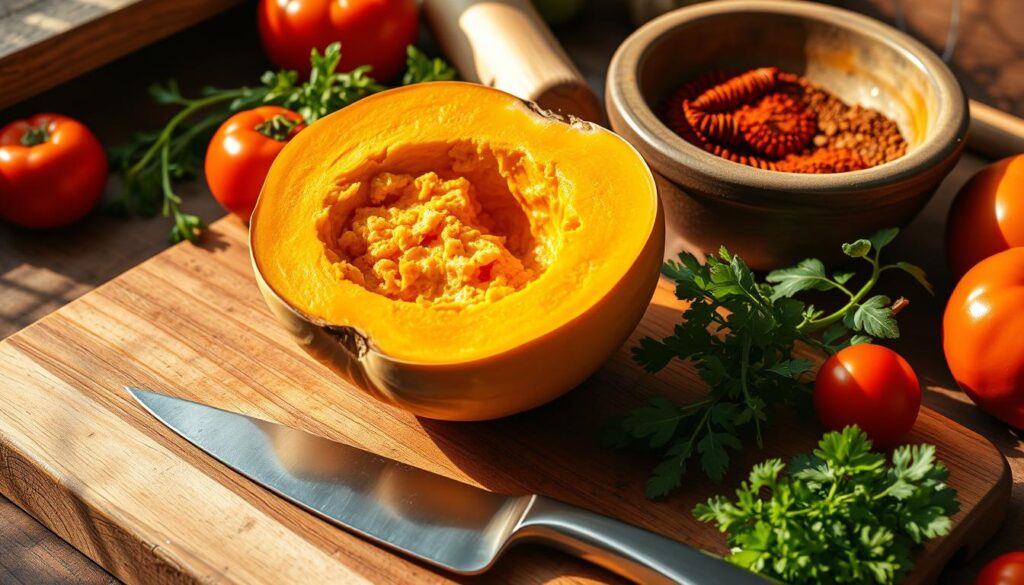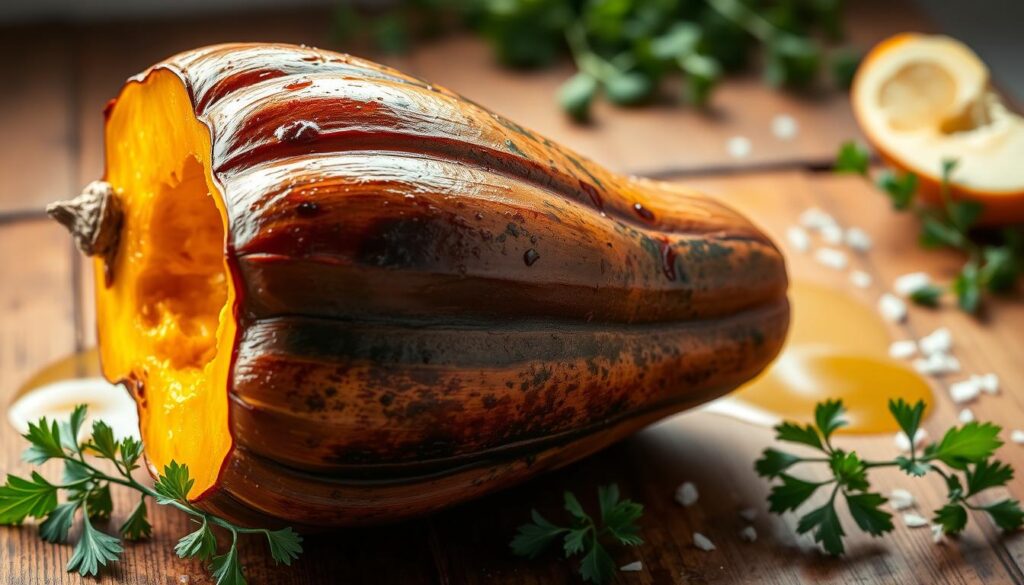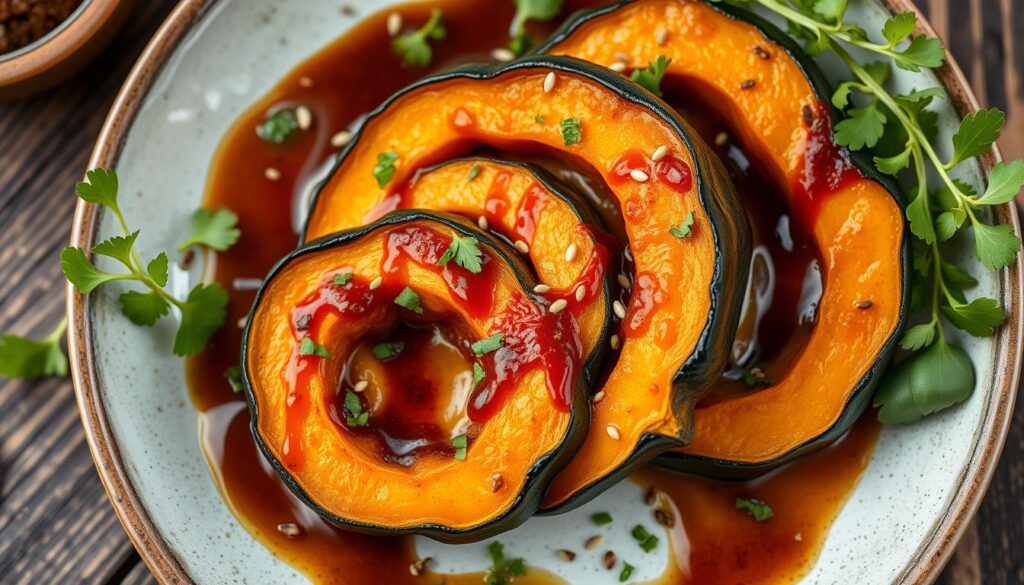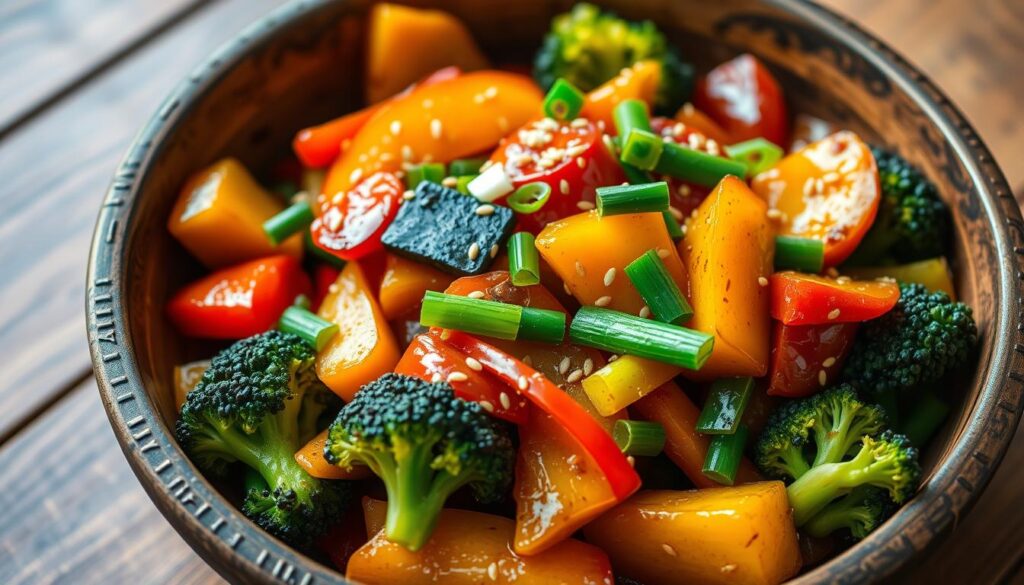Ever wondered how a single ingredient could transform your vegan cooking? Chinese squash recipes kabocha vegan dishes might just be the secret you’ve been looking for! Kabocha squash, often called the Japanese pumpkin, is full of nutrients like beta-carotene, fiber, and antioxidants.
Cooking with kabocha squash opens up a world of tasty, plant-based dishes. Its creamy texture and sweet, chestnut-like flavor make it perfect for creating vegan-friendly Chinese squash recipes that are as satisfying as they are healthy. Roast it, mash it, or use it in hearty stir-fries to elevate your vegan meals.
Prepare to discover simple, delicious recipes that show vegan cooking can be enjoyable, tasty, and wholesome. Whether you’re a seasoned vegan chef or just starting out, these Chinese squash recipes featuring kabocha will inspire your next kitchen adventure.
Understanding Kabocha Squash: The Japanese Pumpkin
Kabocha squash is a culinary gem from Japan that’s changing roasted japanese squash recipes everywhere. It has a vibrant green outside and rich orange inside. This makes for an amazing taste experience.
Nutritional Powerhouse
Kabocha squash is a nutritional superstar. It’s packed with vitamins and minerals. Here’s why it’s so special:
- Rich in Vitamin A and C
- Excellent source of dietary fiber
- Low in calories
- Contains potassium and iron
Selection and Storage Tips
When looking for the perfect kabocha squash, remember these tips:
- Choose squash that feels heavy for its size
- Look for a deep green, uniform color
- Check for firm skin without soft spots
- Store in a cool, dry place for up to one month
Peak Season and Availability
Kabocha squash is at its best from late summer to early fall. Pro tip: Find the freshest ones at farmers markets and specialty stores.
“Kabocha squash is nature’s gift – sweet, nutritious, and incredibly versatile!” – Chef Maria Rodriguez
This squash is transformative for vegan and plant-based dishes. Its creamy texture and sweet flavor make it perfect for roasting, stir-frying, or blending into soups. This Japanese pumpkin will take your cooking to the next level.
Essential Tips for Preparing Kabocha Squash
Cooking kabocha squash is a fun adventure in the kitchen. This Japanese pumpkin brings unique challenges and rewards. Learning how to prepare it will unlock its amazing flavors for you.
Before you start roasting kabocha squash, follow these essential preparation tips:
- Rinse the squash well to eliminate dirt or debris.
- Check for a heavy, firm texture with a deep green, shiny skin
- Inspect the stem – it should be dry and well-attached
- Choose squashes without bruises or soft spots
The best part about kabocha squash? You don’t need to peel it! When cooked, the skin turns tender and sweet, simplifying preparation.
Cutting Techniques
Cutting kabocha squash requires some skill. Pro tip: Microwave the squash for 2 minutes at 600 kW to make it slightly softer. This makes cutting much easier and safer.
“Mastering the cut is the first step to enjoying kabocha’s incredible flavor” – Chef’s Wisdom
When cutting, use these steps:
- Cut the squash in half from stem to base
- Scoop out seeds and stringy membrane
- Slice into uniform half-moons or cubes for even roasting
| Preparation Method | Time Required | Difficulty Level |
|---|---|---|
| Microwaving to Soften | 2 minutes | Easy |
| Cutting Technique | 5-10 minutes | Intermediate |
| Total Preparation | 10-15 minutes | Simple |
Pro tip: Sharp knives are key for safe and efficient kabocha squash preparation!
Basic Roasted Kabocha Squash Recipe
Roasting kabocha squash transforms this Japanese pumpkin into a delicious side or main dish. It has a sweet flavor and creamy texture. Cooking it is an exciting adventure for home chefs.
Get ready to learn a simple yet delicious way to prepare this versatile squash. It will make your meal better with little effort.
Preparation Essentials
First, pick a fresh kabocha squash. Choose one that feels heavy for its size and has a hard, dark green or orange skin. Kabocha squash usually weighs 2-3 pounds and serves many.
- Wash the squash thoroughly
- Cut the squash in half using a sharp knife
- Remove seeds (optional: save for roasting)
- Slice into 1-inch thick pieces or half-moon shapes
Seasoning Possibilities
Make your roasted kabocha squash taste amazing with these seasoning options:
| Seasoning Style | Ingredients | Flavor Profile |
|---|---|---|
| Classic Herbs | Olive oil, salt, black pepper, rosemary | Savory and aromatic |
| Sweet Maple | Maple syrup, cinnamon, sea salt | Sweet and warming |
| Asian-Inspired | Tamari, sesame oil, chili garlic sauce | Umami and spicy |
Perfect Roasting Guide
Cooking kabocha squash needs the right temperature and timing. Follow these steps for the best results:
- Preheat oven to 400°F (200°C)
- Arrange squash pieces on a baking sheet
- Drizzle with chosen seasonings
- Roast for 25-40 minutes
- Flip pieces halfway through cooking
“The key to perfect roasted kabocha squash is even cooking and bold seasonings!”
Your roasted kabocha squash will last 3-5 days in an airtight container. It’s a great meal prep option. Enjoy its sweet, buttery flavor!
Miso Soy Glazed Roasted Kabocha
Discover the perfect blend of Japanese flavors in this delicious kabocha squash recipe. Kabocha, also known as Japanese pumpkin, turns into a tasty vegan dish. It will enhance your repertoire of Chinese squash dishes.
To make the ultimate miso soy glaze, choose the right ingredients. Your dish will come to life with a mix of umami-rich flavors:
- White miso paste
- Soy sauce
- Rice vinegar
- Maple syrup
- Sesame oil
- Fresh garlic
“The magic of kabocha squash recipes lies in their ability to absorb complex flavors while maintaining a creamy, rich texture.”
For the best roast, pick a firm 3-4 pound kabocha squash. Cut it into even wedges for even cooking. Add a sprinkle of fine sea salt and black pepper to enhance its natural sweetness.
| Ingredient | Quantity | Purpose |
|---|---|---|
| Kabocha Squash | 2-3 lbs | Main ingredient |
| White Miso | ½ cup | Flavor base |
| Soy Sauce | 2 tbsp | Umami depth |
| Maple Syrup | 1 tbsp | Natural sweetness |
Roast your kabocha squash at 400°F for 35-40 minutes, turning it halfway. Brush with the miso glaze in the last 5 minutes. This will give you a caramelized, flavorful exterior. Your vegan Chinese squash recipes will be unforgettable.
Chinese Squash Recipes Kabocha Vegan
Exploring vegan Chinese squash recipes with kabocha opens up a world of delicious culinary possibilities. Kabocha squash brings a rich, sweet flavor that perfectly complements traditional Chinese cooking techniques.
Vegan Chinese cuisine transforms kabocha squash into incredible dishes that tantalize your taste buds. The versatility of this Japanese pumpkin makes it an exceptional ingredient for creating authentic and innovative recipes.
Stir-Fry Variations
Stir-frying kabocha squash requires some key techniques to maximize flavor and texture:
- Cut kabocha into uniform 1-inch cubes for even cooking
- Use high heat to create a slight caramelization
- Keep vegetables crisp by quick cooking
- Pair with protein alternatives like tofu or tempeh
Sauce Combinations
Elevate your kabocha squash recipes with these exciting sauce options:
| Sauce Type | Key Ingredients | Flavor Profile |
|---|---|---|
| Black Bean Sauce | Fermented black beans, garlic, ginger | Savory, umami-rich |
| Spicy Sichuan Sauce | Chili oil, Sichuan peppercorns, soy sauce | Intense, numbing heat |
| Ginger-Soy Glaze | Fresh ginger, tamari, maple syrup | Sweet and tangy |
These chinese squash recipes kabocha vegan options transform a simple vegetable into a gourmet experience. Experiment with different techniques and sauces to discover your perfect kabocha squash recipes.
“Cooking is about passion, and kabocha squash offers endless possibilities for creative vegan cuisine.”
Creamy Kabocha Squash Soup
Explore the world of kabocha squash recipes with this luxurious soup. It turns the Japanese pumpkin into a silky, warming dish. Your kitchen will be filled with aromatic herbs and rich flavors, making this soup a comfort food standout.
Kabocha squash adds a unique sweetness to the soup, different from butternut varieties. The deep green or orange squash is a robust base for a nutritious and satisfying soup.
Ingredients You’ll Need
- 1 medium kabocha squash, roasted
- 2 carrots, chopped
- 1 yellow onion
- 8 garlic cloves
- 3 cups vegetable broth
- Fresh herbs: sage and thyme
- 2 tsp apple cider vinegar
Making this kabocha curry-inspired soup is simple. Start by roasting the squash to highlight its natural sweetness. Tip: Microwave the squash for 3 minutes to make cutting easier.
Cooking Method : Chinese Squash Recipes Kabocha Vegan
- Roast kabocha squash until tender
- Sauté onions, garlic, and carrots
- Add roasted squash and vegetable broth
- Blend until smooth using an immersion blender
- Season with fresh herbs
“A perfect soup warms the soul and nourishes the body” – Chef’s Wisdom
Your finished soup is a nutritional powerhouse. It has 136 calories per serving, with 20g carbohydrates, 2g protein, and 6g fat. It’s full of vitamin A and makes a hearty, healthy meal. You can store it in the fridge for up to 5 days.
Make your soup even better with toppings like roasted pepitas, coconut cream, or homemade croutons. These add a special touch to this simple yet elegant dish.
Maple-Glazed Kabocha Dishes
Discover the magic of turning roasted Japanese squash into a culinary masterpiece. Maple-glazed kabocha recipes will take your dining experience to new heights. Kabocha squash’s unique sweetness and complexity pair perfectly with rich maple flavors.
Sweet and Savory Flavor Combinations
Make your kabocha squash recipes extraordinary with strategic glazing techniques. The natural sweetness of kabocha is perfect for maple-based preparations. These balance sweet and savory flavors beautifully.
- Maple-Miso Glaze: Combines white miso paste with maple syrup
- Sesame-Maple Drizzle: Adds nutty depth to roasted squash
- Spiced Maple Variation: Incorporates warming spices like cinnamon
Serving Suggestions
Explore versatile serving options to showcase kabocha squash’s rich flavor and creamy texture.
| Serving Style | Preparation Method | Flavor Profile |
|---|---|---|
| Side Dish | Roasted with maple glaze | Sweet and caramelized |
| Salad Topping | Cubed and maple-glazed | Crunchy and sweet |
| Grain Bowl | Sliced and drizzled | Hearty and complex |
Pro tip: For the ultimate maple-glazed kabocha, roast at 425°F for 35-40 minutes, brushing with a mixture of maple syrup, miso, and sesame oil.
Try these maple-glazed kabocha squash recipes. They’ll turn an ordinary vegetable into an extraordinary culinary experience. It’s perfect for both vegans and food enthusiasts.
Kabocha Curry Variations
Kabocha curry is a vibrant dish that combines the flavors of Chinese squash and vegan cooking. It turns the humble kabocha squash into a culinary masterpiece. Your taste buds will love it.
Kabocha squash is a nutrient powerhouse. It’s full of beta carotene and dietary fiber. Its less watery texture makes creamy, satisfying curries that wow food lovers.
“A great curry is about balancing flavors and celebrating fresh ingredients.” – Culinary Expert
Essential Ingredients for Kabocha Curry
- Fresh kabocha squash
- Coconut milk (1 can)
- Red or green curry paste
- Fresh ginger (1-inch, grated)
- Garlic
- Soy sauce or tamari
- Sesame oil
Curry Preparation Techniques
- Roast kabocha squash cubes at 400°F for 25-30 minutes
- Sauté aromatics like ginger and garlic
- Add curry paste and coconut milk
- Incorporate roasted squash
- Simmer until flavors meld
You can customize your kabocha curry with extra veggies or protein. Serve it over steamed rice or rice noodles. It’s a complete meal that celebrates vegan cuisine.
Nutrition Highlights
| Nutrient | Amount per Serving |
|---|---|
| Calories | 180-220 |
| Protein | 5-7g |
| Fiber | 4-6g |
| Vitamin C | 30% Daily Value |
Pro tip: Adjust curry paste for your preferred spice level. Try garnishes like toasted cashews or fresh microgreens.
Creative Ways to Use Kabocha Seeds
Don’t throw away those kabocha seeds when cooking squash! They are packed with nutrients and can be turned into a tasty snack. Roasting kabocha squash seeds is a great way to reduce waste and enjoy a crunchy, flavorful treat.
- Classic Roasted Method
- Clean seeds thoroughly
- Pat completely dry
- Toss with olive oil
- Sprinkle with sea salt
- Flavor Variations
- Smoky paprika seasoning
- Garlic and herb blend
- Spicy chili powder mix
- Nutritional yeast coating
“Seeds are nature’s little nutritional miracles – compact, powerful, and full of nutritional!” – Culinary Nutritionist
When roasting kabocha seeds, they roast differently than pumpkin seeds. Roast them at 350°F for 15-20 minutes, stirring now and then. This ensures they brown evenly. Keep an eye on them to avoid burning.
These are packed with healthy fats, protein, and essential minerals. Sprinkle these crunchy seeds on salads, soups, or enjoy them as a snack while cooking squash.
Meal Prep and Storage Tips For the Chinese Squash Recipes Kabocha Vegan
Proper preparation and storage are key to maximizing the potential of kabocha squash in cooking. Good storage keeps your squash tasty and nutritious all week long.
Optimal Storage Strategies
Here are some smart ways to store your kabocha squash:
- Store roasted kabocha in airtight containers
- Refrigerate prepared squash for up to 5 days
- Use glass containers to prevent moisture buildup
Freezing Methods
Freezing your squash keeps its flavor and nutrients for later. Here’s how to freeze it right:
- Cut cooked kabocha into uniform portions
- Allow squash to cool completely
- Place in freezer-safe containers or bags
- Label with date and contents
- Freeze for up to 3 months
Reheating Guidelines
Here’s how to reheat your stored squash:
| Reheating Method | Time | Temperature |
|---|---|---|
| Oven | 10-15 minutes | 350°F |
| Microwave | 2-3 minutes | Medium heat |
“Proper storage transforms your kabocha squash from a single meal into a versatile ingredient for multiple culinary adventures.” – Culinary Nutrition Expert
Tip: Thaw frozen kabocha squash overnight in the fridge to maintain its texture and achieve the best results.
Conclusion
Exploring kabocha squash recipes opens a world of tasty vegan dishes. This Japanese pumpkin is low in calories and rich in vitamins like Vitamin C and beta-carotene. It’s a great addition to your meals, thanks to its versatility in Chinese squash recipes.
Kabocha squash adds a sweet flavor to dishes like roasted, stir-fried, or creamy soups. Its skin is edible, and it’s full of fiber and minerals. This makes it perfect for those who care about their health. It’s a great choice for your weekly meals.
As you try new ways to cook kabocha squash, remember it’s easy to work with. From October to December, you can play with different flavors and methods. The most important thing is to have fun and enjoy the health benefits of this winter squash.
Your adventure with kabocha squash is just starting. It’s low in calories, packed with nutrients, and super versatile. It will quickly become a favorite in your vegan cooking. For more inspiration, check out this Boulder’s Enchilada Recipe for a delicious way to complement your squash dishes.
FAQ
What is chinese squash recipes kabocha vegan?
Kabocha squash, also known as Japanese pumpkin, is a sweet winter squash. It has a chestnut-like flavor and creamy texture. It contains abundant nutrients, including beta-carotene, vitamins A and C, and fiber. Its edible skin becomes tender when cooked.
How do I select a good kabocha squash?
Pick a kabocha squash that feels heavy for its size. The best time to find fresh kabocha is from late summer to early fall. Choose squash with a dark green hue and firm skin, free from soft spots or blemishes.
Do I need to peel kabocha squash before cooking?
No, you don’t need to peel kabocha squash. The skin is edible and becomes tender when cooked. Simply wash, dry, and cut the squash into your desired shape before roasting or cooking.
What’s the best way to roast kabocha squash?
Preheat your oven to 400°F (200°C). Slice the kabocha into 1-inch thick pieces, toss with olive oil, salt, and pepper. Roast for 35-40 minutes, flipping halfway through. To enhance flavor, glaze it with maple syrup, cinnamon, or a savory soy-based sauce.
Can I eat kabocha squash seeds?
Yes! Clean and dry the kabocha seeds, toss them with oil and seasonings, and roast for the last 10-15 minutes of cooking. While they might be tougher than other squash seeds, they’re edible and nutritious.
How long can I store roasted kabocha squash?
You can store roasted kabocha in an airtight container in the refrigerator for up to 5 days. For longer storage, freeze cooked kabocha in portions. When ready to eat, thaw overnight in the refrigerator and reheat in the oven or microwave.
What are some vegan recipe ideas using kabocha squash?
Try roasted kabocha with maple glaze, vegan kabocha curry, stir-fried kabocha with Asian sauces, creamy kabocha soup, or incorporate it into grain bowls, salads, and even vegan pizzas.
Is kabocha squash nutritious?
Absolutely! Kabocha squash is packed with nutrients, including beta-carotene, vitamins A and C, and fiber. It’s a low-calorie, nutrient-dense food that can be a great addition to a healthy vegan diet.

